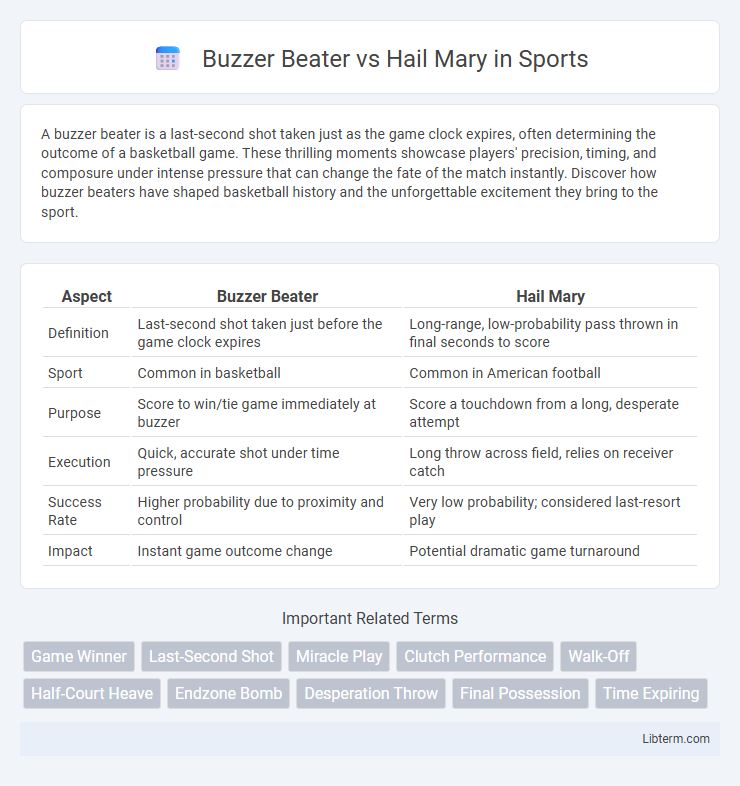A buzzer beater is a last-second shot taken just as the game clock expires, often determining the outcome of a basketball game. These thrilling moments showcase players' precision, timing, and composure under intense pressure that can change the fate of the match instantly. Discover how buzzer beaters have shaped basketball history and the unforgettable excitement they bring to the sport.
Table of Comparison
| Aspect | Buzzer Beater | Hail Mary |
|---|---|---|
| Definition | Last-second shot taken just before the game clock expires | Long-range, low-probability pass thrown in final seconds to score |
| Sport | Common in basketball | Common in American football |
| Purpose | Score to win/tie game immediately at buzzer | Score a touchdown from a long, desperate attempt |
| Execution | Quick, accurate shot under time pressure | Long throw across field, relies on receiver catch |
| Success Rate | Higher probability due to proximity and control | Very low probability; considered last-resort play |
| Impact | Instant game outcome change | Potential dramatic game turnaround |
Definition of Buzzer Beater
A buzzer beater is a basketball shot taken just before the game clock expires, often determining the outcome of a match. It differs from a Hail Mary, which is a long, last-second pass in football intended to score a touchdown under desperate circumstances. Buzzer beaters are celebrated for their precision and timing, embodying clutch moments in basketball history.
What Is a Hail Mary?
A Hail Mary is a desperate, long-range pass made at the end of a football game when the offense has little time left to score. This high-risk, low-probability play aims to catch the defense off guard, often involving multiple receivers in the end zone. Unlike a buzzer beater, which is a last-second shot in basketball, a Hail Mary relies heavily on luck and timing to potentially win the game.
Origins of Buzzer Beaters in Sports
Buzzer beater shots originated in basketball, referring to a last-second shot taken just before the game clock expires, often dramatizing the outcome of crucial games. The term became popularized in the 1980s during iconic NBA moments, emphasizing its role in high-stakes competition. Unlike the Hail Mary, which comes from football, buzzer beaters highlight precision and timing within a confined sports context.
The History Behind the Hail Mary Play
The Hail Mary play originated in American football in 1975 when Dallas Cowboys quarterback Roger Staubach described his last-second, long-distance pass as a "Hail Mary" prayer for success. This desperate, high-risk throw became an iconic moment symbolizing hope and urgency at the game's end. Over time, it has evolved into a dramatic, crowd-pleasing play distinct from the buzzer beater in basketball, which relies on precise timing and skill rather than chance.
Key Differences Between Buzzer Beater and Hail Mary
A buzzer beater is a last-second shot taken as the game clock expires, often a precise jump shot or layup designed to score just before time runs out. In contrast, a Hail Mary is a long, desperate pass thrown deep into the opponent's end zone, typically relying on luck and receiver positioning rather than precise timing. The key difference lies in execution: a buzzer beater is a carefully timed shot, while a Hail Mary is a hopeful, high-risk pass aimed at creating a scoring opportunity in chaotic final moments.
Famous Buzzer Beater Moments
Buzzer Beater moments, like Michael Jordan's iconic 1998 NBA Finals shot, showcase game-winning precision as the clock expires, highlighting instant clutch performance. In contrast, Hail Mary passes, such as Doug Flutie's 1984 Miracle pass in college football, emphasize long-distance desperation throws with low completion probability. Both highlight dramatic finishes, but buzzer beaters often epitomize calm under pressure, while Hail Marys capture hopeful risks in final seconds.
Legendary Hail Mary Completions
Legendary Hail Mary completions in football define thrilling, last-second passes that change the outcome of crucial games. Unlike buzzer beaters in basketball, Hail Marys cover long distances under extreme pressure, showcasing quarterback arm strength and receiver agility. Iconic moments like Doug Flutie's 1984 Boston College pass highlight the dramatic impact of these improbable completions in sports history.
Psychological Impact on Players and Fans
Buzzer Beaters create intense euphoria and immediate relief among players and fans, often boosting team morale and fan loyalty through dramatic, game-deciding moments. Hail Mary attempts induce heightened anxiety and tension, as the low-probability, last-second attempts trigger suspense and emotional extremes for both players and spectators. The psychological impact of Buzzer Beaters is generally energizing and confidence-building, whereas Hail Marys evoke a rollercoaster of hope and despair, reflecting the unpredictability of sudden-death scenarios.
Buzzer Beater vs Hail Mary: Which is Rarer?
Buzzer beater shots in basketball occur when a player scores just as the game clock expires, often seen in the final seconds of close games, making them a dramatic but relatively frequent event compared to Hail Mary passes in football. Hail Mary passes, long, desperate throws launched from deep in a team's own territory to the opposing end zone at the very end of a game, are statistically much rarer due to their low success rates and situational requirements. Therefore, Hail Mary plays are significantly rarer than buzzer beater shots, underlining their unique role as last-ditch, high-risk attempts in sports.
The Cultural Significance in Modern Sports
Buzzer Beater and Hail Mary shots hold immense cultural significance in modern sports, symbolizing clutch moments that define athlete legacies and fan experiences. These iconic plays evoke intense emotional responses, often replayed and celebrated in sports media, shaping narratives around perseverance and unpredictability. Their portrayal transcends the game, embedding itself in popular culture as metaphors for hope and last-minute triumph.
Buzzer Beater Infographic

 libterm.com
libterm.com